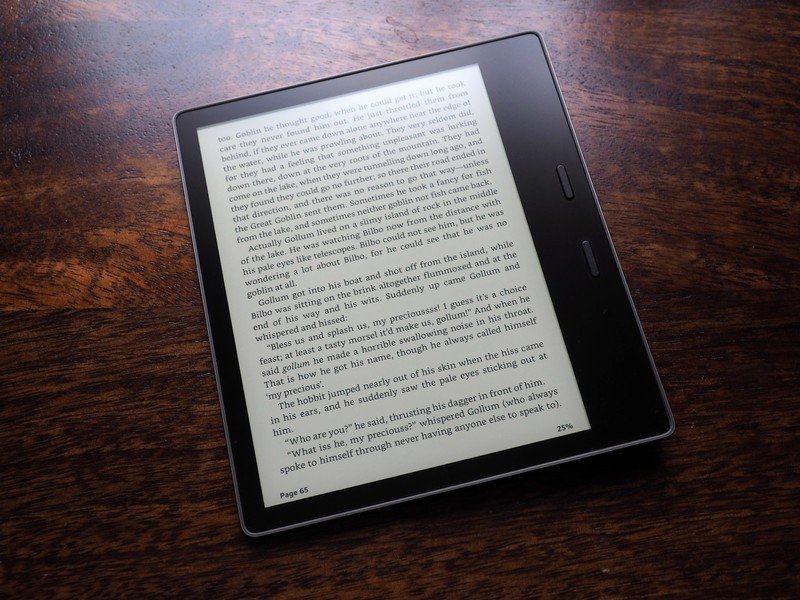The Kindle Oasis has transformed how I read books for the better

There are few products I use more than my Kindle. Over the course of the last decade, I went through seven different models, with the Kindle Paperwhite seeing the most usage. But I ultimately made the switch to a Kindle Oasis in 2018, and it has been a revelation.

There really isn't anything better.
Spending $250 on an e-reader is a sizable investment, but the Kindle Oasis fully justifies the asking price. You get more accurate backlighting and ability to set a warmer tone for reading at night, and the physical page turn buttons are an absolute delight. The asymmetric design mimics that of a folded paperback, and you can take the Oasis to the pool. All these little additions make up a huge difference in the end.
The display on the Kindle Oasis is exquisite

At the outset, the 7-inch display on the Kindle Oasis doesn't seem all that different from the 6-inch screen on the Paperwhite. After all, both devices offer the same 300ppi pixel density, and use the same E Ink Carta display. But where the Oasis pulls ahead is backlighting — it has 25 LEDs embedded around the screen, versus five on the Paperwhite.
The Kindle Oasis gets even better for 2019 thanks to adjustable color balance.
That leads to a much more uniform backlighting on the Oasis, and when combined with the ambient light sensor, the Oasis automatically adjusts the brightness level based on the lighting conditions in the room. It's the ambient light sensor that makes the Oasis so good — particularly in my use case, as I often end up reading late into the night.
The 2019 refresh is even better in this regard, as it lets you adjust the color temperature of the screen. You can set the screen to a warmer tone, thereby reducing eye strain when you're reading at night. Think of it as a blue light filter, but for your Kindle; you even get the same options: you can manually tweak the color balance, or set it to kick in automatically from sunset to sunrise.
Physical page turn buttons make all the difference

Another feature the Kindle Oasis has that's missing from the budget models is physical page turn buttons. The physical action of pressing a button to turn a page is much more satisfying than using the touchscreen, and it is one of the main reasons why I like the Oasis so much. It's hard to quantify just how much of a difference this little feature makes, but after going back to the Paperwhite earlier in the year, I immediately missed the buttons.
Small changes like physical page turn buttons go on to make a huge difference.
I also like the design of the Kindle Oasis. I wasn't immediately taken to it when I got started with it a year ago, but after a few weeks, I got used to the asymmetrical design that's designed to mimic the feel of a paperback in your hand. The aluminum chassis doesn't have that same soft textured finish as the Paperwhite, but I like the fact that the Oasis is lighter. At the end of the day, that makes more of a difference than the texture at the back.
Ultimately, the Kindle Oasis story is one of refinement — you don't need to pay $250 to get a decent e-reader. With the Oasis, you're getting just that little bit more that makes it the best e-reader on the market today. The display is easier on your eyes, page turns are smoother, and physical buttons are an absolute delight. If you've already got a Kindle and are looking to trade up, you'll love what the Kindle Oasis has to offer.
Be an expert in 5 minutes
Get the latest news from Android Central, your trusted companion in the world of Android

There really isn't anything better.
Spending $250 on an e-reader is a sizable investment, but the Kindle Oasis fully justifies the asking price. You get more accurate backlighting and ability to set a warmer tone for reading at night, and the physical page turn buttons are an absolute delight. The asymmetric design mimics that of a folded paperback, and you can take the Oasis to the pool. All these little additions make up a massive difference in the end.

Harish Jonnalagadda is Android Central's Senior Editor overseeing mobile coverage. In his current role, he leads the site's coverage of Chinese phone brands, networking products, and AV gear. He has been testing phones for over a decade, and has extensive experience in mobile hardware and the global semiconductor industry. Contact him on Twitter at @chunkynerd.
